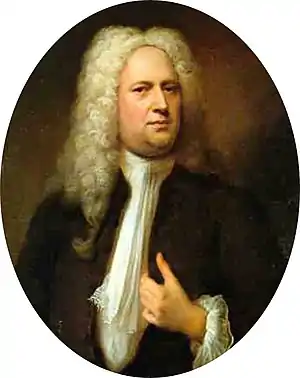| L'Allegro, il Penseroso ed il Moderato | |
|---|---|
| Pastoral ode by George Frideric Handel | |
 Handel portrayed by Balthasar Denner, 1733 | |
| English | The Cheerful, the Thoughtful, and the Moderate Man |
| Catalogue | HWV 55 |
| Year | 1740 |
| Text | by James Harris |
| Language | English |
| Based on | John Milton's "L'Allegro" and "il Penseroso" |
| Performed | 27 February 1740: London Lincoln's Inn Fields |
| Movements | 46 |
| Scoring |
|
L'Allegro, il Penseroso ed il Moderato (The Cheerful Man, the Thoughtful Man and the Moderate Man), HWV 55, is a pastoral ode by George Frideric Handel based on the poetry of John Milton.
History
Handel composed the work over the period of 19 January to 4 February 1740,[1] and it was premiered on 27 February 1740 at the Royal Theatre of Lincoln's Inn Fields. At the urging of one of Handel's librettists, Charles Jennens, Milton's two poems, "L'Allegro" and "il Penseroso", were arranged by James Harris,[2][3] interleaving them to create dramatic tension between the personified characters of Milton's poems (L'Allegro or the "Joyful man" and il Penseroso or the "Contemplative man"). The first two movements consist of this dramatic dialog between Milton's poems. In an attempt to unite the two poems into a singular "moral design", at Handel's request, Jennens added a new poem, "il Moderato", to create a third movement. The popular concluding aria and chorus, "As Steals the Morn" is adapted from Shakespeare's The Tempest, V.i.65–68.
Michael O'Connell and John Powell have published an analysis of Handel's setting of the text in his musical treatment.[1]
Dramatis Personae
- Soprano I
- Soprano II
- Alto (some versions only)
- Tenor
- Bass
- Chorus
There are no characters, no specific 'L'Allegro" or "Penseroso". The "drama" comes from alternating episodes representing the humors. Some versions give arias to different soloists. For instance, the "da capo" version of the aria "Straight mine eye hath caught new pleasures" is sung by a soprano (Gardiner, English Baroque Soloists, Monteverdi Choir, 1980) but the truncated recitative version is sung by a bass (Nelson, Ensemble Orchestra de Paris, 2000). Also, all soloists sing in the "il Moderato" section.
Dance choreography
In 1988, Mark Morris choreographed a dance performance to accompany the music and poetry.[4]
References
- 1 2 Michael O'Connell, John Powell, "Music and Sense in Handel's Setting of Milton's L'Allegro and Il Penseroso" (Autumn 1978). Eighteenth-Century Studies, 12 (1): pp. 16–46.
- ↑ Smith, Ruth. "Jennens, Charles: (1700/01–1773), patron of the arts and librettist". Oxford Dictionary of National Biography. Retrieved 6 October 2013.
- ↑ Ridden, G.M.; Dunhill, Rosemary (October 1998). "Milton's Nightcap: The Correspondence of James Harris". Milton Quarterly. 32 (3): 95–97. doi:10.1353/mq.1998.0016 (inactive 1 August 2023). Retrieved 6 October 2013.
{{cite journal}}: CS1 maint: DOI inactive as of August 2023 (link) - ↑ Review/Dance; Mark Morris Interprets Handel, Kisselgoff, Anna, The New York Times, 8 October 1990
External links
- Full-text libretto hosted at wikisource.
- Score of L'Allegro, il Penseroso ed il Moderato (ed. Friedrich Chrysander, Leipzig 1859)
- Full-text libretto hosted by Stanford University.
- Full-text of Milton's L'Allegro and il Penseroso at Project Gutenberg.
- Text and Commentary on L'Allegro at Dartmouth.edu Archived 2 September 2012 at the Wayback Machine
- Text and Commentary on il Penseroso at Dartmouth.edu Archived 30 July 2018 at the Wayback Machine
- Program notes by Boston Cecilia.
- Notes by Music with Ease.
- L'Allegro, il Penseroso ed il Moderato: Scores at the International Music Score Library Project